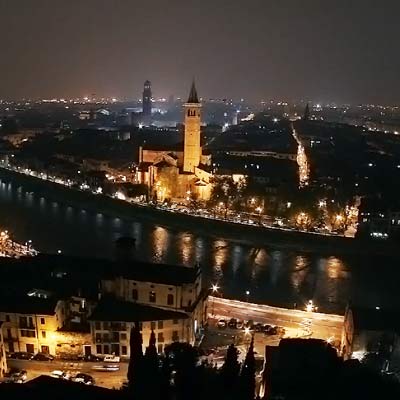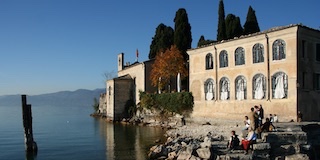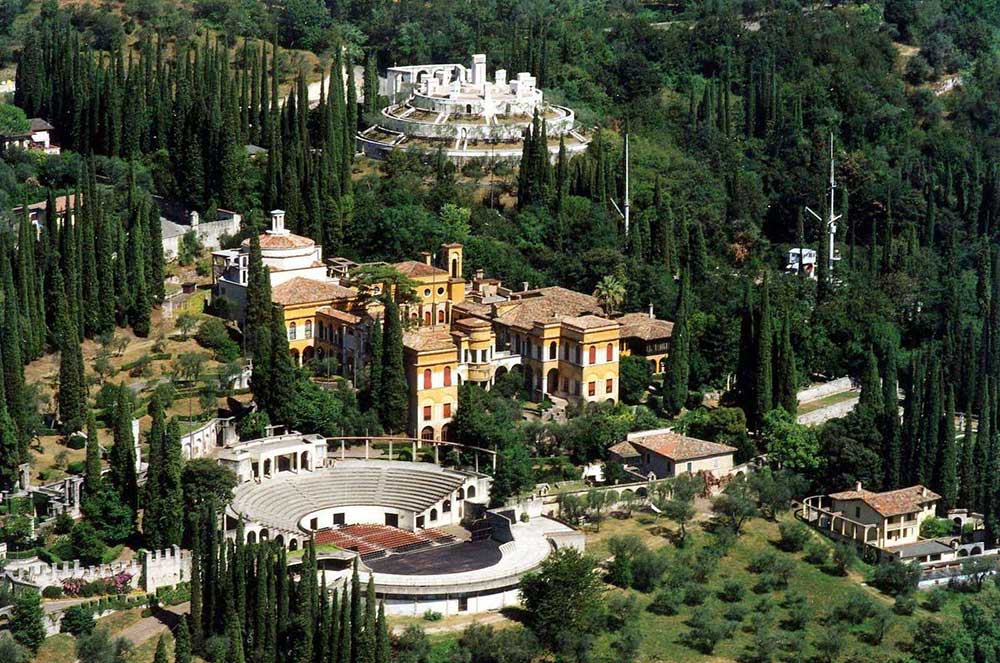Sirmione

A guided tour of Sirmione will let you discover one of the most enchanting places in the whole lake Garda, so beautiful that it is often referred to as the "pearl of the lake". Its magic atmospheres were already described by the Roman poet Catullus in I century b.C..
Oncoming Tours
Info and Bookings:
+39 333 2199 645 info@veronissima.com P.I. 03616420232 C.F. CPPMHL74L13L781C
From the middle of the southern coast of Lake Garda, a very thin strip of land extends for 4 km (2.5 miles) northwards, in some places just 120 m (390 ft) wide. It is the peninsula of Sirmione, one of the most charming places on Lake Garda, celebrated in various periods by poets and artists.
About two thirds up the peninsula is the town of Sirmione, a picturesque village dating back to the Lombard era, although archaeological excavations have brought to light remains from the Roman age, when the most important centre was located further north. It was an immense Roman villa that tradition indicates as the birthplace of Gaius Valerius Catullus, one of the most famous Latin poets.
The Guided Tour of Sirmione

Sirmione can be a destination in its own right for a guided tour that combines history, art, architecture and poetry. Suitable for private tours, or small and larger organized groups, school trips, etc. With a guided tour of 2-3 hours you can visit all the main places of interest:
- Middle age Castle (external and/or internal)
- Villa of Maria Callas (outside)
- Saint Peter in Mavino church
- Catullus' Grotto (Archaeological excavations)
- Panoramic lakeside promenade
Sirmione is also a starting point for boat trips on Lake Garda, from the shortest circumnavigations of the Sirmione peninsula to admire the caves of Catullus and the Scaliger Castle from the water, to longer excursions to Borghese Island, Garda Islands, Salò, etc..
The immediate hinterland of Sirmione is also the production area of Lugana wine. There are numerous wineries where it is possible to take guided tours with wine tasting.

The guided tour starts from the entrance of the village, consisting of the southern walls of the middle age Castle. Today access is by means of of a brick bridge, but originally there was a drawbridge that could be lifted if necessary isolating the village. To create the moat was dug the channel that cuts the tip of the peninsula of Sirmione making it in fact an island.
From the small dock always crowded with fishing boats and yachts you can enjoy a beautiful view of the castle, with the donjon and the curtains of crenellated walls.
The Castle
 The entrance to the castle is on the right just inside the village. On the entrance portal there are still the Scala family coat of arms (the shield with the ladder) and the lion of St. Mark, emblem of the Serenissima Republic of Venice, symbols of two of the powers that ruled over Sirmione.
The entrance to the castle is on the right just inside the village. On the entrance portal there are still the Scala family coat of arms (the shield with the ladder) and the lion of St. Mark, emblem of the Serenissima Republic of Venice, symbols of two of the powers that ruled over Sirmione.
From the courtyard you can climb to the battlement walkways and further up to the keep from where you will enjoy an amazing 360° view of the village and the peninsula of Sirmione. From the top of the keep you can clearly see the small dock of the castle surrounded by walls and towers built in the water, which would have protected the boats that took refuge there from enemy attacks.
The present castle was built by Cansignorio della Scala at the end of the 14th century, enlarging a previous fort perhaps built on a Roman or Longobard tower.
The castle is in a perfect state of conservation.
Gaius Valerius Catullus
Through some narrow alleys you reach Piazza Carducci, the heart of Sirmione, with its busy cafes, hotels, restaurants, pizzerias. From Piazza Carducci there are boarding points from which you can take the public navigation line boats or private motorboats on which to venture on a trip on Lake Garda. Near the dock is the bust of Valerio Catullus.
Gaius Valerius Catullus
Gaius Valerius Catullus was born in Sirmione on 84 BC. His was a family rich and important and gave hospitality to Giulius Cesar on a leg of his journeys to Gaul. To give hospitality to a figure like Caesar needed a proper place. This is one of the clues which leads many to believe that the large and sumptuous villa, whose remains the tradition calls "the caves of Catullus", is actually the place where the famous poet was born and spent his childhood.
 Catullus moved to Rome around 60 B.C. where he led a dolce vita hanging out with other young artists, personalities of the time, charming women. With one of these, Clodia, he fell madly in love, spending a short but intense love story, which ended because of her volubility: "What a woman says to a passionate lover write it in the wind, or in the flowing water". For Clodia, whom Catullus calls Lesbia, the poet wrote unforgettable verses.
Catullus moved to Rome around 60 B.C. where he led a dolce vita hanging out with other young artists, personalities of the time, charming women. With one of these, Clodia, he fell madly in love, spending a short but intense love story, which ended because of her volubility: "What a woman says to a passionate lover write it in the wind, or in the flowing water". For Clodia, whom Catullus calls Lesbia, the poet wrote unforgettable verses.
Catullus joined the poetic movement of the neoteroi, which revolutionized the art and poetry of antiquity. At a time when poetry dealt with "high" subjects, telling of gods and heroes, celebrating the powerful, authors like Catullus spoke instead of small things: love, friendship, nostalgia, writing immortal verses for their universality and modernity. Of course there is no lack of words for his beloved Sirmione as in the carme XXXI.
Catullus' Grottoes
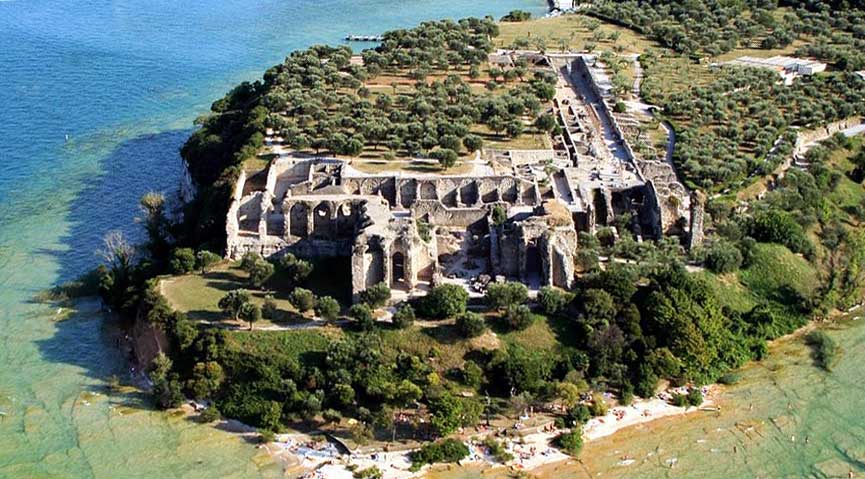
And so let's go visit the grottoes of Catullus. You have to go out
from the village and continue northwards to the extreme tip of the
Sirmione Peninsula. The remains of the ancient Roman villa occupy a surface
of about 2 hectares (5 acres - 20,000 square meters) which makes it the
largest archaeological site in Northern Italy. These are not true
caves of course, but when the villa was abandoned and fell in
ruin, a lush and abundant vegetation grew around and over the
immense structures of the ruins with their recesses and underground rooms,
giving the impression that they were natural caves.
"Caves" in general was what people called the large rooms of buildings and
abandoned structures of ancient Roman age. When, with the
Renaissance, there was the rediscovery of the ancient art, painters descended with
ropes and torches inside these "caves" to study the
decorations on the walls from which they drew inspiration: festoons, masks,
garlands, etc., were then called grotesque, that is to say in the manner of the
grottos paintings.
Villas in ancient times were patrician residences built in the middle of vast
estates. Attached to the main residential building were the rustic buildings where farm labourers and slaves lived. Other buildings were used for operations and transformation activities, and
as storage rooms for the products or barns.
Very little remains of the main body of the villa of Sirmione.
What is impressive today, however, are the remains of the annexes and the
supporting structures that sustained the main body. The villa was
in fact built on an uneven terrain with depressions and differences in heights
which had to be flattened by filling ditches and, where the difference in height was
too accentuated, building a complex system of structures that created a wide platform
on which the residential part was built.
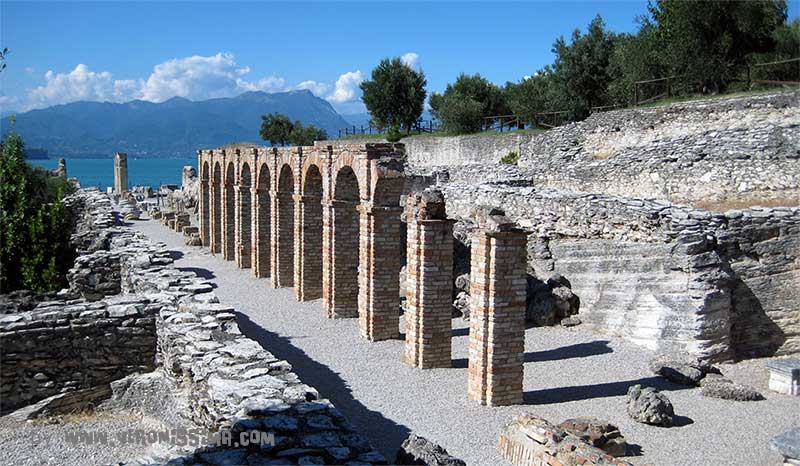
Going up to the top of this platform you pass next to the remains of a wide and long criptoporticus, a double underground gallery whose vaults were held up in the center by a colonnade. It is unknown the actual use of this corridor.
The entrance was probably on the southern side of the villa. Only few signs of the perimeter walls of some large rooms an traces of mosaic are preserved.
The Spa
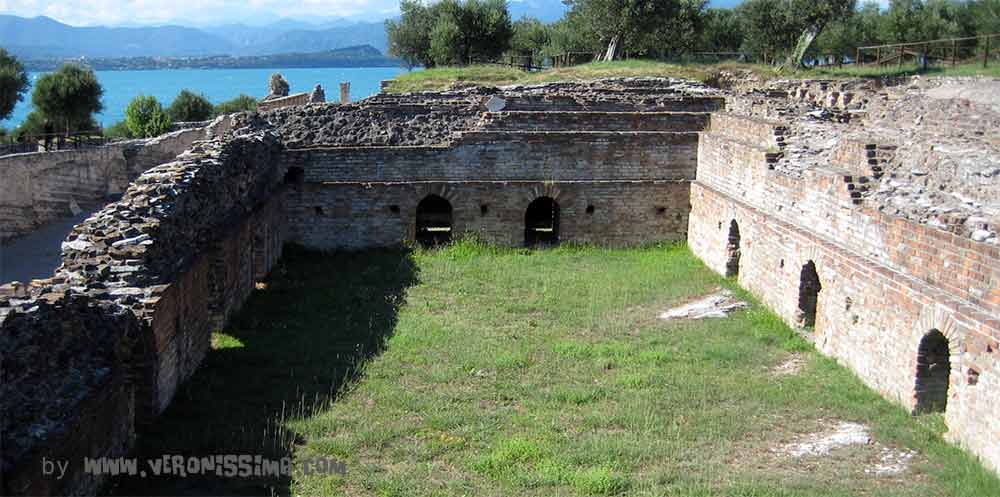
The complex had its own spa. You can clearly distinguish two big rooms, equipped with an ipocaustus, the ingenious system of heating of cavities into which hot air from a furnace was channelled. One, larger, was perhaps the tepidarium for lukewarm water, the other, smaller one, the calidarium for hot baths. One building whose walls have been preserved was probably the cistern that supplied the water to the spa.
The Big Cistern
An even larger cistern is located halfway up the esplanade where the main body of the building was. It was an impressive work, 43 meters (140 ft) of length, 8-9 meters (30 ft) deep, dug into the rock and covered by a vaulted ceiling in bricks arranged in a herringbone pattern which, two thousand years later, is perfectly preserved. It was used to collect the water for any purpose of the entire villa that, built on a rocky spur, was too far from the water of the lake and any underground aquifer.
The Terrace

The north end of the villa was characterized by a large terrace, built on the highest and most imposing of all the structures, right by the lake. The large platform almost completely collapsed. Some perforated stones found among the rubble down below led to the hypothesis that around the terrace there was a system of poles that supported a large velarium, a sort of tent similar to those of theatres and amphitheatres, which shaded the entire surface of the terrace making it a pleasant place even in hot Summers.
One can only fantasize about the magnificence that such a villa was meant to express. Such size and grandeur make one suppose that the finishes and furnishings were of a luxury and refinement with few comparisons, built, among other things, in a particularly uncomfortable place, but with the precise intention of enjoying an unparalleled view of the lake that opens before us in all its magnificence.
Abandon
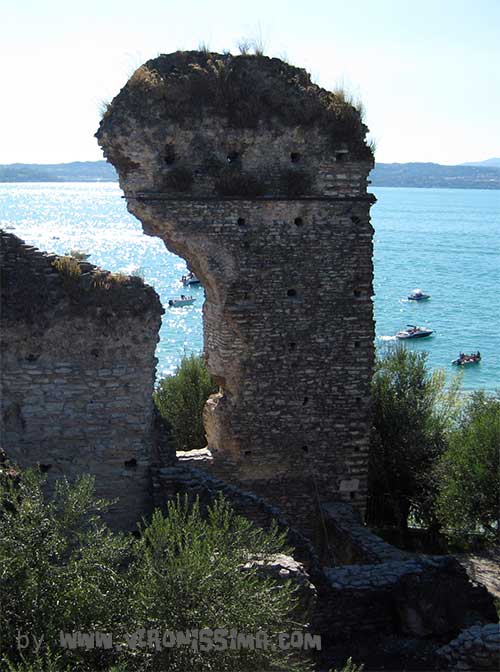
In the 3rd century the villa was abandoned.
The first incursions of the
barbarian invasions made it clear that such a luxurious residence,
in such an open position, impossible to defend, would have been easy
prey to looting and violence.
The decline was rapid and inexorable.
In the Longobard era it became the site of a lookout post and of a
some burials.
The Museum

The guided tour of the Catullus' grottoes ends in the small but
very interesting museum attached to the service building. On display are
the finds unearthed during the various excavation campaigns that have been carried out in the villa and in the
other surrounding areas: fragments of friezes, pottery, oil lamps, bronzes,
coins, inscriptions, milestones.
A fragment of a fresco found in the villa on display in a museum case deserves particular attention.
It depicts a young man holding a scroll, dressed in the typical patrician toga. Many like to think that it the portrait of the young poet Catullus.
Maria Callas

The famous soprano had her debut at the opera festival at the Arena di
Verona in 1947. There she met her husband, Giovan Battista
Meneghini, wealthy entrepreneur. The couple spent their summer holidays in the villa they owned in Sirmione.
You can still visit the places where the divine lived and stayed in
Sirmione, like the Gran Caffè Italia, in the main square of the town,
where Callas used to have her aperitif.
The beautiful Art Nouveau villa, no longer owned by the Meneghini family, is
still visible just outside the town and included in the guided tours of Sirmione.
The Spa

Sirmione is also an important spa. In 1889 some divers
discovered at the bottom of the lake just off the peninsula of Sirmione a
spring from which water leaked out at almost 70 C° (150 F°) of temperature.
Some speculated that the Romans already knew and exploited the hote water. This however is quite unlikely as the source is located at
15 meters (50 ft) deep and only the development of diving equipment
allowed the discovery.
The sulfurous waters of Sirmione have proved effective
in the treatment of certain respiratory and hearing disorders, but
they're ideal just for light-hearted relaxation.
The water was channelled and is still distributed to thermal spas and to
some hotels.
During the boat trips that circumnavigate the Sirmione peninsula, the
boatmen often stop right on the spot above the source. If the
lake is calm enough you can see the thick bubbles
when they reach the surface and perceive the typical sulfur smell.
Panoramic Promenade

At the end of the guided tour of the Caves of Catullus we will return towards
the village along the beautiful promenade that runs along the lake on the
eastern side of the peninsula.
You will then pass along the thermal water pumping station.
near which you can smell the characteristic smell of sulphur.
The excess water is fed back into the lake through pipes of
overfilled. Someone, years ago, built a kind of dam...
by amassing stones around the gutter, thus creating a rudimentary
swimming pool on the lake where the hot water accumulates allowing to
free use of the spa.
Along the panoramic promenade you can enjoy some suggestive
views of the castle and the village.
Navigation on Lake Garda
From Sirmione it is possible to make boat trips, both on the Garda Navigation Company's vessels that make regular connections with all the villages of Lake Garda, as well as with the numerous private boats with where it is possible to agree personalized tourist itineraries around the peninsula or in various areas of the lake, accompanied by tourist guides who illustrate the history, art, nature and curiosities of the area.
For info and guided tours:
+39 333 2199 645 info@veronissima.com P.I. 03616420232 C.F. CPPMHL74L13L781C

 IT
IT 日本
日本 DE
DE FR
FR 中文
中文 ES
ES